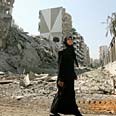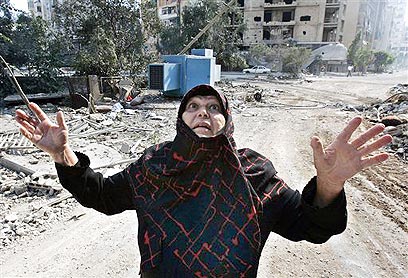
AP Beirut photo faces questions
Woman appears 'mourning destruction of her home' in two photographs allegedly taken two weeks apart in different locations; foreign media remains largely hostile to Israel
"Either this woman is the unluckiest multiple home owner in Beirut, or something isn't quite right," noted the author of the Drinking From Home blog.
In the first photograph, taken by Reuters, a woman is seen in front of a bombed out building in Beirut. "A Lebanese woman wails after looking at the wreckage of her apartment, in a building, that was demolished by the Israeli attacks in southern Beirut," Reuters said in its caption. The photo was dated July 22 2006.
A second photograph of a woman who looks exactly like the woman in the first Reuters image, even bearing the same scar on her left cheek, is then supplied by the Associated Press.

Photo: AP
"A Lebanese woman reacts at the destruction after she came to inspect her house in the suburbs of Beirut, Lebanon," the Associated Press caption claimed. The date accompanying the photograph is August 5 2006, and the scenes behind the woman are different to those of the July 22 photo.
After receiving "some emails" about the photos, the BBC removed the Associated Press image from its own website.
The Associated Press has so far not responded to requests by Ynetnews for an explanation of the mysterious time gap.
Meanwhile, sections of the foreign media are continuing to display uneven coverage of Israeli and Lebanese casualties of war and scenes of destruction.
A BBC photo display entitled "In pictures: Conflict impact," made up of eight images, uses six out of eight pictures to illustrate damages in Lebanon, but pays scant attention to the human toll and large-scale damage sustained in northern Israel.
The photographs show images of Lebanese civilians and bombed out buildings and Beirut, and carry captions such as: "A woman in Beirut cries amid the destruction."
After the BBC says fighting is hampering aid deliveries in southern Lebanon, an image of an Israeli soldier praying is shown, covering his ears while an IDF canon goes off in the background. "But ground clashes in the area continue unabated," the BBC wrote, suggesting through the image that the Israel bore most of the responsible for clashes. There are no photographs of Hizbullah rockets, or Hizbullah members firing rockets at Israel in the series.
Only the seventh photograph in the succession shows an image of an Israeli woman mourning at a funeral, with the caption "Israelis are also counting their losses."
The last picture in the series is of an Israeli in an air raid shelter, but the person in the photo is made black by shadows, and appears to be a silhouette of a human figure. The person's age, sex, or any human features are impossible to make out – an odd choice by the BBC considering the large number of available photographs of Israeli children and families in bomb shelters.
The BBC's website photo editor, Phil Commes, has also taken a neutral line on the faked photographs from Beirut supplied by Reuters, saying: "One man's color balancing is another man's grounds for dismissal."
Washington Post journalist: Israel wants rocket attacks on itself
Meanwhile, Washington Post journalist Thomas Ricks told CNN that Israel was deliberately allowing Hizbullah to fire rockets at its civilians.
"One of the things that is going on, according to some military analysts, is that Israel purposely has left pockets of Hezbollah rockets in Lebanon, because as long as they're being rocketed, they can continue to have a sort of moral equivalency in their operations in Lebanon," Ricks said.
Ricks added that "that's what military analysts have told me."
In addition, a caption provided by the AFP under a photo of rockets in Lebanon read: "Rockets fired from Israel are seen falling in the outskirts of the southern Lebanese port city of Tyre."
However, the USS Neverdock blog has spotted a contradiction, with Reuters writing under a photograph which appears to be identical: "Hizbullah missiles streak the sky as they are launched towards Israel from south Lebanon."
After analyzing the contradiction, the blog says: "Notice also the credit for the two pictures goes to two different photographers but they look like the exact same photo to me. One just has the buildings in the foreground cropped out. Was that done to disguise the fact that they are the same photo?"
Several blogs have been busy finding many more clues to forged and staged photographs, many of them taken by disgraced photographer Adnan Hajj. In particular, reports and images claiming that the IDF struck an ambulance are being challenged as false.
And in yet another suspicious case, two Reuters photographs of a Lebanese man holding a picture of Hassan Nasrallah has been challenged by the Jawa Report blog.
The same man is seen holding Nasrallah's picture and saluting with glee, but the background for each photo of the man is dramatically different. While in one image a clear, blue sky can be seen, a second image of the man flashing a victory sign shows a dusty background, suggesting a bomb had recently been dropped in the area. Two buildings also mysteriously disappear the second photo, although both photographs seem to have been taken from the same location.
"Does this represent a dramatic change in the local architecture and air quality between the two shots, or was this yet another Lebanese stringer Photoshop project?" asks the blog's author, before
concluding: "Only the photographer knows for sure."










